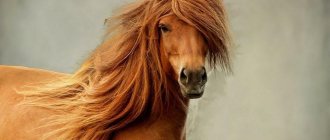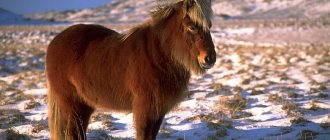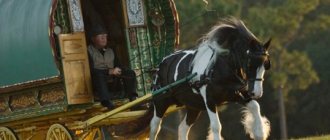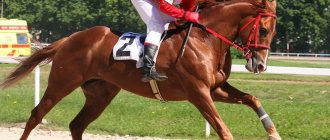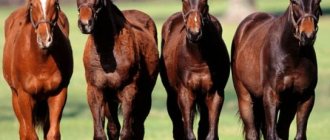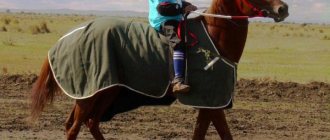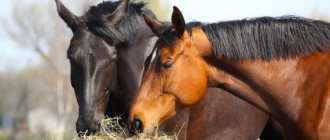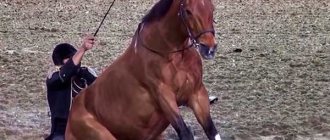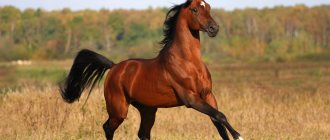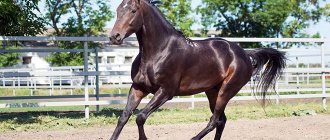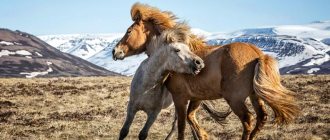As one of the oldest domesticated horse breeds, the Akhal-Teke Horse (Akhal-Teke Horse) was bred to produce a hardy and speedy horse.
Some riders find this breed too lean and narrow, different from the more common muscular riding horse breeds. Others consider him a work of art, elegant in appearance and gait. Whatever the opinion, the Akhal-Teke is one of the rarest, exotic full-size horse breeds in the entire world.
History and origin of the Akhal-Teke horse
This is an ancient breed whose history goes back thousands of years. It may have descended from the same ancestors as the more famous Arabian breed.
The breed originated in the Karakum desert of Turkmenistan, where horses had to endure a lack of water and food, as well as heat and cold. The Akhal-Teke lived with nomadic people, each of whom was necessary for the survival of the other.
After Turkmenistan joined the Russian Empire in 1881, the first official Akhal-Teke breeding farms were created. At that time, the breed was named after the Turkmen Teke tribe, who lived near the Ahal oasis.
Interesting Facts
- Horses of this breed can go without water for a long time and cover a distance of up to 250 km per day. This is a kind of endurance record for equid animals.
- Behind the graceful appearance of the breed lies incredible strength and endurance. There are known cases when an Akhal-Teke horse, wounded in battle with a saber, carried two adult men away from pursuit through the quicksand of the desert.
- The former head of the USSR Nikita Khrushchev presented the Queen of England with the Akhal-Teke stallion Melekush of Isabella color. The golden skin of the horse shocked the royal grooms so much that they decided that the horse had been painted. But all attempts to wash the animal with shampoo were in vain.
- The Akhal-Teke horse is depicted on the coat of arms, currency and postage stamps of Turkmenistan. In Ashgabat and some other cities of this state there are monuments dedicated to the Akhal-Teke.
- An Akhal-Teke mare named Lisette was the favorite of the Russian Emperor Peter I. The horse shared with the emperor all the hardships and hardships of the Northern War, including the Battle of Poltava.
- The most famous sports races are associated with horses of this breed In 1935, Akhal-Teke riders covered the distance from Ashgabat to Moscow in 12 weeks. Participants covered the Karakum in three days, without stopping to eat or sleep. The horses reached Moscow in full force.
- At international auctions, Akhal-Teke horses are valued as highly as high-quality Arabian horses. Argamaki are deservedly popular among connoisseurs of the breed and are kept in elite stables.
Breeding and use of Akhal-Teke horses
The nomadic tribes of Turkmenistan mainly used these animals for transportation. They selectively bred their horses for speed, endurance and agility, which were valuable qualities for raiding.
Currently, the breed is used for dressage, show jumping, long-distance running and pleasure riding. In Russia, such a horse is a status symbol.
The positive characteristics of this breed resonate throughout the racing world. More than 200 purebred Akhal-Teke horses were sent to Britain in the 17th and 18th centuries for breeding, and their genes contributed to the creation of modern racehorses.
Scope of application
Basics
Akhal-Teke horses are universal. Therefore, they are used everywhere - in sports (in all three disciplines - show jumping, eventing and dressage), racing, jogging and for the hobby class.
Even in poor conditions, where it is hot and there is no winter, Akhal-Teke horses can easily run 200 kilometers a day.
The only work that Akhal-Teke horses do not perform is transporting loads in a harness and plowing the land in a plow. These animals are not suitable for village “dirty” work.
Where do they perform better?
Akhal-Teke horses often set records and won medals. At the 1980 Olympics, Akhal-Teke horses were one of the most promising and popular breeds.
They easily take hurdles up to 2 meters, and due to their excellent endurance and good standing start, they are used in cross-country cross-country (eventing).
Akhal-Teke horses also perform well in vaulting and horse riding (showing acrobatic tricks on fast-running horses in a straight line or on a line in the presence of an observer). But here they are less popular than in other equestrian disciplines.
Colors of the Akhal-Teke horse
Animals have thin skin and very fine hair. All horse colors and markings are accepted in the breed registry. Some horses have light blue eyes.
In addition, many individuals have a metallic sheen to their fur. This is because their hair lacks the opaque center of the typical horsehair shaft.
Thus, it refracts light and appears to glow. Most horses, especially cream ones, have a golden sheen. For gray horses this is a silver sheen.
Appearance
Let's start the description with the breed standard.
Akhal-Teke horses are tall horses. Their height at the withers is on average 155 cm. But what is more impressive is not the height of the Akhal-Teke horse, but the volume of its chest. It averages 180 cm. Sometimes there are individuals with a chest volume of almost 200 cm. The body length differs slightly from the height at the withers and varies from 150 to 160 cm. Accordingly, the horse has a square body format. But such proportions do not make the appearance of the Akhal-Teke horse angular. It is worth looking once at a representative of the Akhal-Teke breed to recognize these horses among other breeds.
Let's figure out what makes Akhal-Teke horses so recognizable.
- The Akhal-Teke has a very elegant head, on which expressive eyes are located. The horse's profile is straight. The head ends with wide nostrils, which in no way spoil the aristocratic profile. Small ears are set high on the head. They fit harmoniously into the image. It is worth noting that the ears of Akhal-Teke horses are unusually mobile. The long neck, matching the head, is elegant and quite thin.
- Straight legs have well-developed muscles. At the same time, the long legs look, like the head, gracefully. The leg ends in a miniature but hard hoof. Despite its elegant appearance, the horse is capable of walking more than 200 km a day.
- The long back has well-developed muscles, the back of the body is slightly sloping, and the tail is set quite low. The Akhal-Teke horse cannot boast of a bushy tail. But it is worth noting that the hair of representatives of this breed is thin and soft.
- The chest of the Akhal-Teke horse breed is not wide, the stomach is tucked, and the ribs are positioned straight.
This is a general description of the breed. But within the breed there is a division into 3 types. The first type includes the tall Akhal-Teke, which is characterized by long and graceful lines. This type is most often found in nature. The second type includes Akhal-Teke dogs of medium height. Their lines are less graceful and, indeed, less long. The last type is short and stocky horses. Accordingly, they are the least popular.
Color
Akhal-Teke horses have a wide variety of colors. There are even representatives of the Isabella color here.
The soft and pleasant to the touch fur of the Akhal-Teke mare can be dyed gold with a hint of red. Golden-salt and golden-bay horses are also found. Dun and black suits are no less common, and gray color is also common.
But the Akhal-Teke horse of Isabella color is quite rare. The coat has a cream color, which is why they sometimes call it not an Isabella horse, but a cream Akhal-Teke horse. In the photo she looks like a mythical animal that came from a fairy tale world. The Akhal-Teke horse of Isabella color has pink skin, which shines through the light wool, shimmering in the sun. Purebred representatives of this color have green or blue eyes.
Representatives of the Isabella color can cost millions of dollars. But even for those who can afford to spend such a sum, it is not so easy to buy them due to their small number.
Common Health and Behavior Problems in Akhal-Teke Horses
The animals are somewhat lacking in genetic diversity. This makes the breed susceptible to several genetic health problems, including:
- Cervical vertebral malformation (also known as wobbler syndrome): In this condition, neurological deficits cause the horse to have a stiff, uncoordinated gait. Medical intervention can help manage symptoms.
- Cryptorchidism: This is the absence of one or both testicles in the scrotum, making castration difficult and sometimes causing other health and behavioral problems. The animal produces testosterone, which can make it temperamental.
- Hairless foal syndrome: This causes foals to be born hairless. They have abnormalities of the teeth and jaws, and are prone to developing other digestive problems, pain, and more.
Nutrition
The diet of this breed of horse is not very different from others, except for the need for water. They grew up in hot climates and therefore can go without water for quite a long time.
Akhal-Teke horses eat hay and fresh grass if they have access to it. You can feed them only with good hay, then they will be energetic and cheerful even without additional feeding, this is especially important for sports horses.
If there is high physical activity, then you should not feed oats or barley. It is much better to pamper with beets, carrots or potatoes. Additionally, soybeans or alfalfa are given for muscle development.
The fiber they contain will make the horses' bones and teeth stronger and their coat silkier. Vitamins should be given only if there is a need for it. Horses need to be fed at the same time. Start the meal with hay, then give succulent or green food.
Caring for the Akhal-Teke horse
Standard care is all the breed needs. Brush and brush your horse once or twice a week to remove dirt, debris and tangled hair. Wash your horse regularly to give it a metallic shine. Inspect and clean his hooves daily to look for injuries and prevent infections.
pros
- Athletic
- Loyal
- Intuitive and smart
Minuses
- Can be excitable and difficult to handle
- Prone to genetic health problems
Champions and celebrities among Akhal-Teke horses
The Akhal-Teke horse is the national symbol of Turkmenistan and is depicted on the country's coat of arms and currency. It can also be seen on stamps and in many monuments.
One of the most famous Akhal-Teke horses was a stallion named Absentee, who won a gold medal in individual dressage at the 1960 Olympic Games.
By the end of his career, he had won medals at two more Olympic Games. Absent produced several horses that were talented in dressage and jumping.
Is the Akhal-Teke horse right for you?
This is a surprisingly resilient breed that has adapted to the harsh conditions of its homeland. The animal performs well in almost any climate. The Akhal-Teke is always alert, but for some riders and owners, especially beginners, it can be too energetic and restless.
Many members of the breed also do not like being ridden by strangers and will only team up with one person. They often need a gentle, experienced hand during training.
But if you bond with one of these horses, you will have a loyal friend for life. Many owners say that their Akhal-Teke horses seem to be able to read their minds and only need a small gesture or whisper to guide their horses. Moreover, some individuals are known to protect their owners like guard dogs, even biting other people they perceive as a threat.
Comparison with other breeds
Akhal-Teke horses are special horses. They require specific handling and an individual approach. This breed is not suitable for a novice owner, and if not handled properly the animal can become aggressive and dangerous.
Akhal-Teke horse
They are considered excellent horses, so they are widely used for racing and competitions. However, they reach their peak of physical fitness late, only by 3-4 years of age do they enter sexual maturity and are not known for good fertility. With proper training and handling, they reveal themselves in all their glory during races at the hippodrome, where they are competed only by Arabian and Russian horse breeds. You may also be interested in information about what the Arabian horse breed looks like and how it is kept.
Buying an Akhal-Teke
There are less than 10,000 Akhal-Teke horses in the world, most of whom live in Turkmenistan and Russia.
These horses cost an average of about $10,000, although this price can rise significantly depending on age, health, training and pedigree.
Akhal-Teke dogs with a strong metallic sheen to their coats are also often more expensive. When considering one of these horses, aim to spend time with them before making a purchase. Find out from the breeder the horse's history, his health... And make sure he has a temperament that you can control.
How to choose a stallion
The price of Akhal-Teke horses depends on several factors. First of all, this is the purity of the breed. Not only are purebred horses flawed in appearance, but they are also less durable. Also, the purity of the breed affects the way it walks - if you need a horse to participate in competitions, it is better not to save money when purchasing.
Also, the cost of a foal is affected by its color. A horse, for example, of dun color will cost less than an Isabella horse. The gender of the stallion and the pedigree of the parents are two other factors that influence pricing. Do not exaggerate the importance of pedigree. The descendants of famous horses do not always win awards. It is worth paying attention to the presence of inherited diseases in horses. You also need to look at the appearance, length of the lines and height of the horses that participated in the crossing. The appearance of the foal largely depends on the genotype of the parents.
The cost of a purebred stallion with good genetics can exceed $10,000. For a half-breed you will have to pay 4 times less. You can save money if you buy a stallion online by reading bulletin boards. But such a purchase is very risky. It will be impossible to check the pedigree or assess the health of the animal. The only option is to look at the photo of the Akhal-Teke horse.
It is best to go shopping at a nursery. They make sure that only healthy individuals who do not have a predisposition to genetic diseases are allowed to crossbreed. For example, if parents have problems with joints, this will certainly manifest itself in some generation. Such a horse will not achieve high results in sports competitions.
